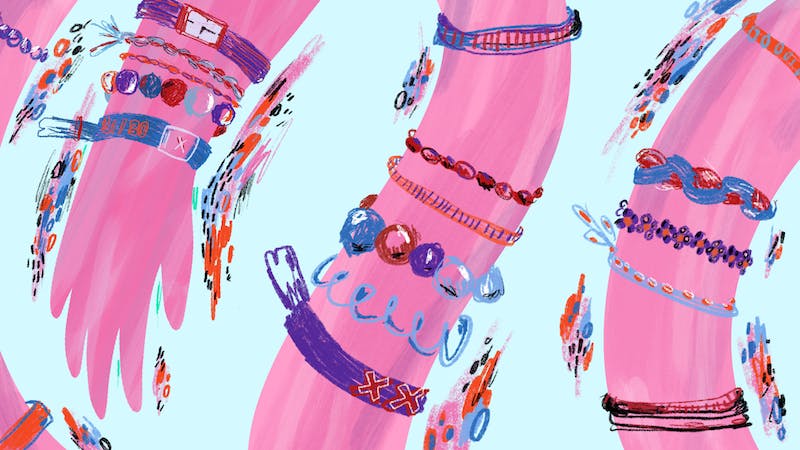
Coco Chanel famously said, “Before you leave the house, look in the mirror and take one thing off.” Coco sure knew her tweeds and pearls, and the archetypal, streamlined, sophisticated Chanel woman would still probably turn her nose up at many of our cluttered wrists and jangling keyrings. But, just as some would argue that Thanksgiving is all about the sides or that the Super Bowl is all about the commercials, accessories are often the key to making a look tick. Before we had any notion of personal style, many of us chose accessories as a channel for expression: homemade friendship bracelets denoting our strongest ties, pierced ears looked upon with envy as a signal of growing up, playground weddings under the slide, complete with a Ring Pop.
If we express ourselves through our fashion choices, accessories are windows to the soul. The choices we make in how we supplement our personal style have always meant more than a simple aesthetic decision, and it becomes only more evident as we grow older. We may have thrown out our Rainbow Looms and string, but accessories still reign supreme as signifiers of our values, relationships, and personalities. In considering the role of accessorizing in self–expression, I found myself considering what, exactly, an accessory is. We may automatically think of bags and jewelry, and certain notable accessories come to mind in cementing identities: Jackie O.’s sunglasses, Blair Waldorf’s headband, or the famous pearls of Audrey Hepburn as Holly Golightly in Breakfast at Tiffany’s.
But the concept of an accessory is a blurry one and much broader than one might expect—depending on the context, accessorizing could either get you in Vogue or sent to jail. Teen drama Gossip Girl‘s bad–boy–heartthrob Chuck Bass, in discussion with his college runaway stepsister, says of members of their elite enclave of Upper East Side society, “For people like us, a college degree is just an accessory. Like a Malawi baby or a poodle.” Clearly, accessories occupy a space in the cultural conscience beyond fashion—so, what makes an accessory, and how do unorthodox accessories manifest as modes of expression?
One typical way of defining an accessory is “an item used to contribute, in a secondary manner, to an individual’s outfit.” In style bibles like Vogue and Women’s Wear Daily, this takes on a conventional spin: articles concerning accessories discuss hair barrettes, spangled belts, and knit leg warmers. According to Cornell’s Legal Information Institute, an accessory is “someone who aided or contributed to the commission or concealment of a crime”—less driving cap, more getaway car–driver. Your enabling friend covering your tracks on a messy night is an undeniable accessory to what she’ll never tell. The neon–orange–strawed Dunkin cup dangling from your hand is an accessory in itself, indicating the all–important facet of personality—coffee preference—and, possibly, indicating priorities, if said coffee cup is hauled in a few minutes after class begins, accompanied by sheepishly muttered apologies.
There’s a particular subset of pieces that offers a framework for the breadth and significance of the accessory: the status symbol, a term used to describe particular pieces or possessions that “indicate a person’s wealth or high social or professional status.” Status symbols have ranged from expensive pieces of jewelry and elusive party invitations—more archetypal expressions of social or economic status—to more abstractly impressive, “If you know you know” assets like designer dogs or a particular kind of license plate. A status symbol isn’t necessarily the most expensive or exclusive of things, but given the social environment in which a certain accessory is brandished, something that seems relatively insignificant can hold much more weight than its tangible value.
This phenomenon is well–documented in literature, particularly social portraits such as Edith Wharton’s The Age of Innocence, F. Scott Fitzgerald’s This Side of Paradise, and several of Jane Austen’s novels, in which the positions of characters are often only slightly differentiated based on how they accessorize. The style of Wharton’s Madame Olenska, expressed by things like a velvet robe and an eagle–feather fan, signifies her position as an outsider in New York society. For Fitzgerald’s Amory Blaine, having slicked–back hair and tortoise–shell glasses indicates membership of the social category of “slicker”: someone who “had brains, social brains, that is, and he used all means on the broad path of honesty to get ahead, be popular, admired, and never in trouble.” Like Blaine and Wharton’s protagonist Newman Archer, we often imbue value in very particular appendages of style and use these loosely defined accessories, consciously or not, as symbols of their wearer’s values and place in the world.
The idea also translates to college campuses. A weekend’s raggedy wristband stubbornly hanging on may tell you where someone has been and where they’re going. When you see someone walking with corded earbuds vs. AirPods vs. over–the–ear headphones, you may find yourself inadvertently adjusting your conception of who they are. A perfectly average person who you then notice is riding an electric scooter suddenly becomes something different. To the prophets of pop culture (or teenage girls on TikTok), the definition of accessory expands—girls can’t leave the house without an emotional support water bottle, which invariably incorporates itself into every outfit. Many use these ever–present water bottles as blank slates to sticker into oblivion, telling you all about the person carrying it without having to exchange a word. Computers, too, often find themselves falling into a sticker frenzy and coming out the other side as bona fide accessories, indicators of personality and taste.
These things wouldn’t traditionally fall under the category of “accessory,” but in many ways, they serve the same purpose of contributing peripherally to our understanding of a person, expressing individuality in a way that we typically would reserve for personal style. Even if we don’t realize it, we’ve encoded these “accessories” with certain significance and meanings and use them to understand the world around us.
This post was originally published on this site be sure to check out more of their content.








